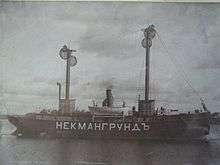Hiiu Shoal
| Hiiu Shoal Nekmangrund Hiiu Madal | |
|---|---|
 Hiiu Shoal (Baltic Sea) | |
| Coordinates: 59°3′N 22°15′E / 59.050°N 22.250°ECoordinates: 59°3′N 22°15′E / 59.050°N 22.250°E | |
| Sea | Baltic Sea |
| Area | Off Hiiumaa |
| Country | Estonia |
| Minimum depth | 1.2 m |
Hiiu Shoal (Estonian: Hiiu madal) or Nekmangrund is a shoal located in the Baltic Sea, off the northwestern shores of Hiiumaa Island.[1] It is known as Neckmansgrund in Swedish, as Nekmangrund in Russian and as Neckmangrund in German, the loan translation in Estonian being Näkimadalad.[2]
The submerged shoal is 9 kilometers long and 5.5 kilometers wide. Its shallowest point is only 1.2 meters deep at the time of the lowest astronomical tide.
History
Since it is a dangerous shoal for ships entering the Gulf of Finland while approaching St. Petersburg, the Nekmangrund —a lightship of the Russian Hydrographic Office, was anchored on the reef in former times. The wreck of the ship lies now on the bottom of the Hiiu Shoal,[3]
 Lightship Nekmangrund (1898) |
The Sheaf Water, a cargo ship of the United Kingdom, ran aground on the Nekmangrund Shoal on 19 June 1933. She was refloated a week later.[4]
In 1984 Estonian writer Herman Sergo published the novel Näkimadalad, whose title is based on the name of the shoal. In his three-volume work Sergo portrays the tragic fate of the Estonian Swedes of Reigi village, located to the south of the shoal on Hiiumaa Island, which were deported in the 18th century to Southern Ukraine following a Russian Imperial decree.[5]
See also
References
- ↑ "Hiiu Madal, Estonia". Google Maps. Retrieved 31 August 2016.
- ↑ Linda Kaljundi. "Eesti lugu: Herman Sergo "Näkimadalad"". Eesti Päevaleht 19 December 2008
- ↑ Lightship "Nekmangrund"
- ↑ "Casualty reports". The Times (46475). London. 20 June 1933. col G, p. 5.
- ↑ Estonian Literature